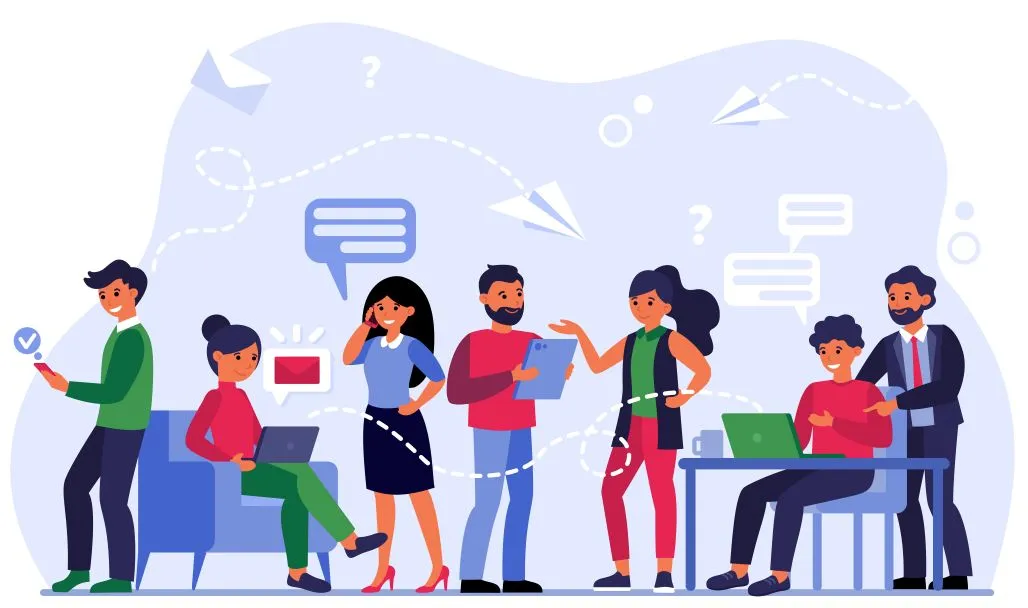Most workplace challenges don’t come from lack of talent—they come from lack of communication. Missed emails, unclear feedback, or confusing meetings can stall projects faster than any skill gap. That’s why communication isn’t a soft skill—it’s a business-critical one.
Strong communication drives collaboration, reduces conflict, and builds trust between employees and leaders. When teams communicate clearly, they move faster, make better decisions, and stay engaged. On the other hand, poor communication drains productivity, frustrates employees, and weakens culture.
According to Sociabble’s 2025 report, poor communication costs companies an average of $12,506 per employee every year—driving disengagement and reducing productivity Similarly, Pumble’s 2025 workplace communication survey found that 86% of employees cite ineffective communication as the main cause of workplace failures.
This sets the stage for why workplace communication training isn’t optional—it’s essential.
Why Workplace Communication Training Matters More Than Ever

Today’s workplace looks very different from even five years ago. Teams are spread across time zones, employees come from diverse cultural backgrounds, and collaboration often happens more through screens than in person. In this environment, miscommunication isn’t just frustrating—it can derail entire projects.
Effective communication in the workplace training ensures employees feel heard and understood, boosting engagement and retention. Employees who feel heard and understood are more likely to stay motivated and committed to their organization. On the flip side, unclear or inconsistent communication is one of the top reasons employees disengage or leave their jobs.
For leaders, communication shapes credibility. A manager who communicates with clarity, empathy, and transparency builds trust far faster than one who doesn’t. That’s why workplace communication training has become a critical investment—it strengthens not just day-to-day interactions, but the very culture of the organization.
We’ve seen why communication is the backbone of collaboration, leadership, and culture. But theory alone won’t change results—it’s the skills your employees actually practice every day that make the difference.
8 Key Workplace Communication Skills for HR Leaders and Managers
Workplace communication skill training should cover practical communication training topics that employees can use every day
1. Active Listening: The Foundation of All Communication
The first—and most overlooked—skill in workplace communication on skill training is listening. Too often, employees focus on how to reply rather than how to truly understand.
Active listening training helps employees slow down, paraphrase what they’ve heard, and ask clarifying questions. This ensures fewer misunderstandings, smoother collaboration, and stronger trust between colleagues.
2. Giving and Receiving Feedback
Feedback can either inspire growth or create tension. In workplace communication skill training, teaching employees and managers how to give clear, respectful, and actionable feedback is critical.
Equally important is learning how to receive feedback without defensiveness. Training on both sides creates a culture where feedback is seen as support, not criticism. This approach is central to workplace communication skill training initiatives.
3. Nonverbal Communication
Nonverbal cues—such as body language, tone of voice, and facial expressions—play a major role in how messages are received. Misaligned signals can create misunderstandings, reduce trust, or even undermine authority.
Workshops as part of workplace communication skills training help employees:
Project confidence during meetings, presentations, and client interactions.
Spot inconsistencies between verbal messages and body language in others.
Build stronger rapport with colleagues, clients, and stakeholders.
Manage their own nonverbal signals to ensure clarity and credibility.
For managers and team leaders, mastering nonverbal cues is especially critical. Whether leading a large presentation, negotiating with clients, or facilitating team discussions, understanding body language and tone of voice can enhance influence, drive engagement, and foster a culture of trust.
4. Virtual & Hybrid Communication Skills
Remote and hybrid work have redefined what “effective communication in the workplace training” looks like. It’s not just about video calls—it’s about clarity, tone, and presence in a digital-first environment.
Training should cover:
Writing concise, professional emails and chat messages
Managing virtual meetings effectively
Using collaboration tools without overwhelming team members
And because not every employee struggles with the same challenges, organizations should consider offering a personalized learning path. This ensures each employee gets the right support—whether they need to improve written communication, virtual presentation skills, or collaborative tool usage.
Thus, organizations benefit when workplace communication on skill training is embedded in daily digital interactions
5. Conflict Resolution & Difficult Conversations
Conflicts are inevitable in any workplace, but mishandled disagreements can harm morale, reduce productivity, and even lead to employee turnover. That’s why workplace communication training should include practical strategies for de-escalating tense situations and resolving conflicts constructively.
Key communication training topics in conflict resolution include:
Staying calm under pressure: Techniques for managing emotions and responding thoughtfully rather than reacting impulsively.
Addressing issues directly but respectfully: Encouraging open dialogue while maintaining professionalism and mutual respect.
Finding common ground: Identifying shared goals or interests to create win-win solutions.
Turning conflicts into opportunities for collaboration: Using disagreements as a springboard for innovation, better processes, or stronger teamwork.
Active listening and empathy: Understanding the other party’s perspective to foster trust and reduce misunderstandings.
HR involvement and policies: Knowing when to escalate issues and how to apply company guidelines effectively.
HR leaders who prioritize this training often report fewer workplace grievances, stronger team relationships, and improved employee engagement. When employees are equipped with the tools to handle conflicts confidently, teams become more resilient, collaborative, and aligned toward shared goals.
6. Cross-Cultural Communication
As workplaces become increasingly global, communication training must address more than just literal language skills. What’s considered polite or assertive in one culture might be perceived as blunt, evasive, or even disrespectful in another. Without awareness, these differences can lead to misunderstandings, strained relationships, or reduced collaboration.
Effective communication in the workplace training, including cross-cultural communication helps employees:
Recognize and respect cultural norms and values, ensuring messages are received as intended.
Adapt verbal and non-verbal communication to suit diverse audiences.
Avoid stereotypes or assumptions that may unintentionally offend.
Develop inclusivity by understanding and appreciating different communication preferences and work styles.
Navigate high-context versus low-context cultures, understanding when indirect or direct messaging is appropriate.
Build trust and collaboration across geographically and culturally diverse teams.
As explained in a comprehensive guide on cross-cultural training, this kind of learning helps teams adapt their communication—whether that’s navigating high-context feedback or understanding non-verbal norms across cultures.
For global organizations, these skills are critical not just for teamwork but also for client interactions, negotiations, and leadership effectiveness. Training in cross-cultural communication creates a respectful, cohesive, and high-performing environment, enabling teams to operate efficiently across borders and time zones.
7. Storytelling for Business Impact
Facts inform, but stories inspire. Training employees—especially leaders—in storytelling builds their ability to motivate teams, persuade stakeholders, and present ideas persuasively.
Storytelling training includes:
Structuring a narrative with a clear beginning, middle, and end
Using real-world examples to make points relatable
Balancing data with human stories for maximum impact
Storytelling is often overlooked in workplace communication skills training but it helps leaders inspire and influence effectively
8. Leadership & Communication Styles
Every leader has a natural communication style, but not every style resonates with every employee. Effective workplace communication training helps leaders:
Identify their default communication tendencies.
Learn to adapt their style to diverse audiences, personality types, and situations.
Balance authority with approachability to maintain respect without creating distance.
Communicate complex messages clearly, reducing confusion and errors.
This training doesn’t just improve day-to-day interactions—it strengthens leadership pipelines, ensures consistent messaging across teams, and cultivates a workplace culture where feedback is received positively and ideas flow freely. Employees feel heard, leaders are more effective, and the organization benefits from better alignment, collaboration, and overall performance.
How It Works in Practice
Remote team misalignment: A marketing manager sends vague feedback like “make it better.” Without clarity, designers waste hours revising. With communication training, managers learn to give structured, actionable feedback, saving both time and frustration.
Cross-cultural misunderstanding: In one culture, being direct is seen as efficient; in another, it feels rude. Training equips employees to recognize these differences, reducing friction and building trust in global teams.
Everyday emails: An unclear subject line or missing next steps often leads to confusion. Training on concise writing helps employees draft emails that get quicker responses and fewer follow-ups.
Team meetings running long: Without clear agendas, discussions go off-track and decisions get delayed. Training teaches employees how to structure meetings, keep conversations focused, and wrap up with clear action points.Conflict escalation: A simple difference in opinion turns into workplace tension because neither party knows how to communicate calmly. Training in active listening and conflict resolution helps turn disagreements into constructive problem-solving.
Benefits of Workplace Communication
Boosts Productivity – Clear communication reduces errors, saves time, and ensures employees know exactly what’s expected of them. Well-designed communication training for employees reinforces these habits, helping teams stay efficient.
Strengthens Collaboration – Teams share ideas more openly, resolve conflicts faster, and work together toward common goals. Interactive communication workshops for employees provide a safe space to practice collaboration skills.
Enhances Employee Engagement – When employees feel heard and valued, motivation and job satisfaction rise. Covering practical communication training topics such as active listening and feedback ensures employees feel more connected.
Improves Leadership Effectiveness – Leaders who communicate well can inspire trust, provide direction, and drive performance. Managers benefit when they engage in communication workshops for employees, building credibility and empathy.
Reduces Turnover – A transparent communication culture makes employees feel connected, reducing frustration and attrition. This is why many organizations integrate specific communication training topics into onboarding and ongoing learning.
Supports Innovation – Open dialogue encourages creativity and diverse perspectives, leading to better problem-solving.
Builds a Positive Work Culture – Respectful, inclusive communication fosters trust and creates a healthy workplace environment.
Tailoring Training for Lasting Impact
Every workplace faces unique communication challenges, which means a one-size-fits-all approach rarely works .Effective communication in the workplace training should be customized for different teams and roles. For example, a new hire may need support in presenting ideas confidently during meetings, while an experienced manager might benefit from learning how to give constructive feedback without sounding overly critical. Remote teams often struggle with misinterpretations caused by brief emails or chat messages, whereas cross-cultural teams may encounter misunderstandings due to different communication norms. Thus, communication training for employees works best when customized for their roles, whether they are new hires or experienced managers
By tailoring training to these specific situations organizations enhance workplace communication skill training effectiveness.—whether it’s improving presentation skills, practicing active listening, or mastering conflict resolution—organizations create learning experiences that are relevant, practical, and sustainable. This personalized approach ensures employees not only build stronger communication skills but also apply them effectively in their daily work.
Example 1: A tech startup noticed new hires often stayed quiet in brainstorming sessions. After tailored presentation and confidence-building workshops, participation increased by 40%, leading to more innovative ideas being shared.
Example 2: A global consulting firm trained managers on cultural sensitivity in feedback delivery. By adjusting communication styles across regions, employee satisfaction scores improved significantly, especially among international teams.
Practical Communication Training for Employees
Not all organizations face the same challenges, which is why tailoring programs around the right communication training topics is essential. From active listening to conflict resolution, focusing on everyday scenarios ensures relevance.
Effective workplace communication skills training should be interactive, blending role-plays, real-world examples, and feedback sessions. When organizations invest in structured communication training for employees, they build stronger, more confident teams ready to handle challenges across cultures, roles, and work environments.
Bringing It All Together

Workplace communication training isn’t just about improving the way employees talk—it’s about creating a culture where trust, collaboration, and clarity thrive and reinforces effective communication in the workplace training for measurable impact. When HR leaders, L&D teams, and managers focus on these eight essential skills, they unlock more than smoother conversations—they lay the groundwork for a high-performing, cohesive organization:
Conflicts transform into opportunities for growth: Employees learn to navigate disagreements constructively, turning challenges into learning experiences.
Teams become more inclusive, connected, and aligned: Strong communication ensures everyone understands goals, expectations, and each other’s perspectives.
Employees feel confident to share ideas and feedback: Open dialogue encourages innovation, continuous improvement, and employee engagement.
Collaboration directly drives performance and results: When teams communicate effectively, projects move faster, decisions are better, and outcomes improve.
Leadership and influence grow naturally: Managers who communicate clearly inspire trust, motivate their teams, and foster accountability.
Employee satisfaction and retention improve: Feeling heard and understood reduces workplace stress and builds loyalty.
The best part? With modern, AI-powered learning platforms like Calibr, workplace communication training no longer has to be generic or one-size-fits-all. Personalized learning journeys help employees practice real-world scenarios, receive instant feedback, and build lasting skills. From interactive role-plays to scenario-based modules, training becomes engaging, measurable, and directly tied to organizational outcomes.
In the end, workplace communication isn’t just a competency—it’s the foundation of leadership, the driver of engagement, and the heartbeat of organizational success. Companies that invest in targeted communication training see stronger teams, more innovation, and measurable improvements in performance and culture.


